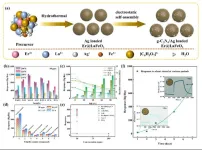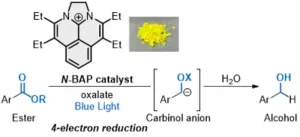(Press-News.org) Peer-reviewed – Qualitative study - Humans
A new study has provided an in-depth look into the rising trend of disposable vape use among young people in the UK.
The research, led by the University of East Anglia, reveals that young people see smoking and vaping as interchangeable, but are far more aware of the potential harms of vaping than they are of the dangers of smoking.
The findings also suggest that banning disposable vape products or increasing their prices could lead young people to revert to smoking tobacco.
Many of the young people questioned also believed that if disposable vapes were banned they would be able to continue using them by stockpiling or purchasing illegally.
Lead researcher Caitlin Notley, a Professor of Addiction Sciences at UEA’s Norwich Medical School, said: “Youth use of disposable vapes has surged in recent years in the UK.
“Despite this increase, little was previously known about the motivations behind this trend and the experiences of young people who use these products.
“This study aimed to explore these aspects, providing valuable insights into the factors influencing youth vaping behaviour.”
The study recruited 29 young people aged between 16 and 20 and a range of methods were used to probe their motivations, experiences and perceptions of using disposable vapes.
Each approach was chosen to best suit the needs of the participants - from individual interviews with researchers, to recorded conversations in friendship pairs using prompt cards without a researcher present, to small group interviews designed to support those with special educational needs.
The key findings include:
Individual Motivations: Participants highlighted key characteristics of disposable vapes that appealed to them, such as affordability, ease of access, and the attractive designs, colours, names, and flavours.
Behaviour Patterns: Many young people engaged in both vaping and tobacco smoking, viewing these behaviours as interchangeable based on the context. There was a common misconception about the relative harms of vaping compared to smoking.
Social and Emotional Factors: Experimentation with vapes was prevalent, and many young people used vapes to manage stress and anxiety. Vaping was also identified as a social activity, widely accepted among peer groups. Notably, participants were more informed about the potential harms of vaping than those associated with smoking.
Regulation: Strict regulatory measures, such as banning disposable vape products or increasing their prices, could lead young people to revert to smoking tobacco. Many of the young people believed that if disposable vapes were banned they would be able to continue using them by stockpiling or purchasing illegally.
Co-author Dr Ian Pope, from UEA’s Norwich Medical School and an emergency physician, said: “Disposable vapes are particularly attractive and accessible to young people in the UK, contributing to the normalisation of vaping within this demographic.
“Despite recognising the potential health risks, young people continue to engage in both vaping and smoking, often interchangeably.
“The widespread availability of underage vape sales and availability of illicit vapes further exacerbates this issue.”
The researchers say the study suggests that young people’s use of disposable vapes could be reduced by tighter enforcement of age of sale and restricting packaging and marketing.
However, they also say the evidence suggests these sorts of interventions have the potential for significant unintended consequences, including increased use of illicit vapes and, most worryingly, increased tobacco use amongst young people.
Prof Notley said: “Therefore any interventions to combat use of disposables may need to be accompanied by policy interventions to reduce access to illicit vapes and tobacco and increase awareness of the relative harms of tobacco compared to vapes.”
The research was conducted in partnership with the Norfolk and Norwich University Hospital and the Nicotine, Tobacco and Vaping Research Group at London South Bank University.
The study was funded by the Norfolk and Norwich University Hospital Foundation Trust through the National Institute for Health and Care Research’s Research Capability Fund.
‘Young People’s use of Disposable Vapes: A Qualitative Study’ is published in Addiction.
END
How disposable vapes have become a prominent part of young people’s lives
2024-06-17
ELSE PRESS RELEASES FROM THIS DATE:
Berberine could treat eczema-exacerbated staph infections
2024-06-16
Atlanta, Ga.—Eczema, a skin inflammatory disease that causes dry, itchy and inflamed skin, affects millions worldwide. Eczema is associated with an altered skin microbiome and higher colonization by Staphylococcus aureus. The study, led at New York Medical by postdoctoral fellow Anish R. Maskey, Ph.D., focuses on the natural compound berberine and its impact on eczema exacerbated by S. aureus. The findings, presented at ASM Microbe, shed light on berberine’s ability to inhibit S. aureus colonization and alleviate eczema symptoms without adverse effects.
Current ...
NIH-funded intervention did not impact opioid-related overdose death rates over evaluation period
2024-06-16
A data-driven intervention that engaged communities to rapidly deploy evidence-based practices to reduce opioid-related overdose deaths – such as increasing naloxone distribution and enhancing access to medication for opioid use disorder – did not result in a statistically significant reduction in opioid-related overdose death rates during the evaluation period, according to results from the National Institutes of Health’s HEALing (Helping to End Addiction Long-Term) Communities Study. Researchers identified the COVID-19 pandemic and increased prevalence ...
Protein-rich diets may influence gut microbiome and body composition
2024-06-15
Atlanta, GA – New research has shed light on the effects of protein-rich diets on the gut microbiome and overall health. Despite the increasing protein intake in Western diets, especially among athletes and individuals with obesity, the fate of undigested protein and its impact on human health remains largely unknown. A new study, presented at ASM Microbe, explores how excess undigested protein in the colon can be fermented to produce beneficial metabolites, such as short-chain fatty acids (SCFAs), or lead to the production of harmful metabolites like ammonia and sulfides, which are linked to gastrointestinal disorders and other health issues.
The research team conducted a series of experiments ...
Sulfur metabolites linked to neurodegenerative diseases
2024-06-15
Highlights:
Mouse studies suggest a link between the gut microbiome and neurodegenerative diseases, but the pathways remain unclear.
New study reports distinct bacterial and metabolite profile in patients with Alzheimer’s disease and other neurodegenerative diseases.
The study flagged the metabolite DHPS as a possible missing link in our understanding of how gut microbes influence NDDs through sulfur metabolism pathways.
Atlanta, Ga.—Neurodegenerative diseases (NDDs), which have no known cures and elusive causes, result in irreversible damage to the brain and nervous system. Research into these diseases typically focuses on the brain, but mouse ...
Insights into the salivary glands
2024-06-15
TLS are accumulations of lymphoid cells that share similar cellular compartments, organization, and function as secondary lymphoid organs. Importantly, the presence of these structures in inflamed salivary glands associated with active disease, increased autoantibody production, and malignancy risk.
“To treat patients effectively, comprehensive understanding of the salivary gland microenvironment is needed”, said Saba Nayar, “but current profiling efforts often struggle to capture high-plex 'omics data while preserving the spatial architecture of the tissue.”
To ...
Holistic approach to care
2024-06-15
The 16-week Plants for Joints trial investigated the effects of a multidisciplinary lifestyle intervention in people with RA, as compared to usual care. The intervention was based on a whole-food, plant-based diet – alongside physical activity and stress management. Previous reports showed this intervention significantly reduced the 28-joint disease activity score (DAS28) compared to usual care alone.2,3 To expand on this, the researchers wanted to determine the long-term effectiveness of the intervention, specifically with ...
Ultra-high sensitivity for isoamyl alcohol based on g-C3N4 nanosheets incorporated Ag nanoparticles loaded Er0.05La0.95FeO3 heterojunctions with enhanced moisture resistance
2024-06-15
The volatile of isoamyl alcohol released from the stored wheat increased with the storage extending, making it one of the potential biomarkers for the early-stage of wheat mildew. Currently, there is a scarcity of chemiresistors for isoamyl alcohol detection, which suffer from low sensitivity. The team of material scientists led by Professor Chao Zhang reported that LaFeO3-based sensing materials demonstrated remarkable sensitivity for isoamyl alcohol (DOI: 10.1039/D3TA05718F, 10.1007/s11666-024-01740-4). However, it’s essential to note that there is still potential for lowering the optimal operating temperature and enhancing moisture ...
Reduction of esters by a novel photocatalyst
2024-06-15
The sweet smell of strawberries and other fruits is thanks to a chemical compound called ester, which is also found in many fats and polyesters. The ubiquitous compound can be broken down to produce desirable alcohols and other chemicals for use across industries including pharmaceuticals and cosmetics, but the process can be costly, both financially and in terms of the environment.
Now, a team of researchers with the National Institutes of Natural Sciences (NINS) in Japan has developed a novel approach using light as an energy ...
Is there a link between increased headaches and hotter temperatures for individuals with migraines?
2024-06-15
As temperatures rise, so do chances for migraine attacks, according to a new study from a team of researchers at the University of Cincinnati College of Medicine, Icahn School of Medicine at Mount Sinai, Errex Inc. and Teva Pharmaceuticals USA. Inc.
“Weather change is one of the most common trigger factors for migraine,” says Vincent Martin, MD, director of the Headache and Facial Pain Center at UC's Gardner Neuroscience Institute and UC Health physician. He is the study’s lead author and president of the National Headache Foundation.
These findings from the study, which looked at use of Fremanezumab and whether it could prevent headaches ...
When bacteria are buckling
2024-06-15
Cyanobacteria are one of the oldest and most important life forms in the world – for example as they took an essential part in producing the oxygen in our atmosphere. Some types form long filaments composed of a few to more than 1,000 individual cells. In this form, the filamentous bacteria can move around. The principles of this locomotion have now been investigated by a research team led by Stefan Karpitschka, group leader at the MPI-DS and professor at the University of Konstanz, in collaboration with the University of Bayreuth and the University of Göttingen.
"We measured the force during locomotion on individual ...



